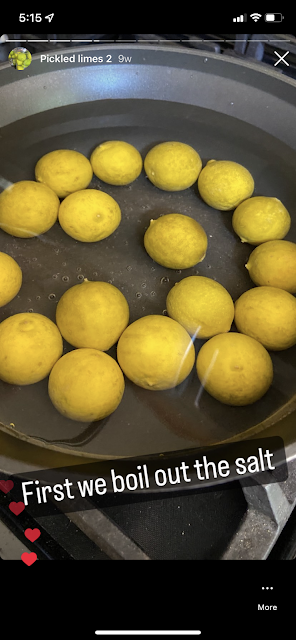And so they were! Thanks friends.
In fact, both the sweet and sugar-free versions were such a hit I went home with motivation to make them again! So it's likely these will pop up in my future. But for now, let's review how this batch was made.
As with my first experiment, the limes were washed and then jarred with salt water using a 1tbs:2c salt:water ratio. They stayed in the salt water for 1 week, then were boiled twice in plain unsalted water. Changing out the water and repeating the process helps draw salt from the limes - it can be done many times, but I stopped at the second because I'm impatient.
After boiling, the limes were divided in half and put into their jars while I got the vinegar mixtures ready. For the unsweetened mix, I used the same recipe as my first experiment, which comes from The Boston Cooking-School Magazine vol. 17 (1912):
Make a brine strong enough to float an egg and in quantity to cover a dozen limes. Let stand six days stirring the brine each day. Drain and set to boil in two quarts of boiling water. Let boil fifteen minutes. Let drain and become cold. Scald one quart of vinegar half an ounce of cloves half an ounce of mace half an ounce of ginger root half an ounce of horse radish and one ounce o f white mustard seed and pour over the limes disposed in fruit jars. Close securely. These are best after keeping some months.
This recipe is half a century later than our target decade, but aligns pretty closely to the spices described in plum pickle and lemon pickle recipes I have from 1869. So I think it's a decent guess at what might have been used. I also ended up throwing in a couple of cardamom pods because I had them, and I like cardamom. But that was a personal addition!
The second batch was the sweet pickled lime recipe I found in another volume of the same Boston Cooking-School Magazine (vol 16, also 1912). While period descriptions of pickled limes eaten in Boston explicitly say they are not sweet, I also have tariff records from 1824 listing "limes preserved in sugar" as an import. In fact, there's a number of sources referencing limes preserved in sugar or syrup throughout the 19th century. So while these aren't the limes Amy March was sucking on, I think it's possible she could have encountered them (maybe when on tour with Aunt March in Europe)...and I wanted to try them.
The recipe is much plainer than the spiced vinegar brine:
[After boiling saltwater limes] Make a thick syrup of sugar and water using a half cup of vinegar to a quart of water. Cook the syrup until it is as thick as molasses, let it get cold. Prick each lime two or three times with a silver fork. When they and the syrup are cold put them together and let them stand over night. The syrup will then be thinned by the juice of the limes. If it is too watery boil it over again. Put the limes in jars and pour the cold syrup over them. They will keep indefinitely if nobody knows they are in the store closet. |
| Jamie, pickled lime doubter, taste testing on mic for Let Genius Burn |










I’m glad you posted these follow ups! I just started reading your posts on pickled limes today and was disappointed with the lackluster results of the first experiment, thinking it’s one of those old foods that sounds good but actually sucks for modern day tastes. But I’m excited to hear that the results are much different when using key limes. I think I might try this little experiment soon!
ReplyDeleteIn the book it's mentioned they are transported in a "moist brown-paper parcel". Could they be stored this way for hours?
ReplyDeleteI think you could! My guess is that they would be dried off a bit before you put them in the bag, so there's not excess brine.
DeleteI forgot to ask: how do you eat them? Biting directly, peeling first?
ReplyDeleteBiting them directly :) we cut them into pieces to share but they do fit in your mouth in one bite (or you could suck on them, as Amy does in the novel!)
Delete